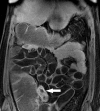The future developments in gastrointestinal radiology
- PMID: 28839691
- PMCID: PMC5551948
- DOI: 10.1136/flgastro-2012-100121
The future developments in gastrointestinal radiology
Abstract
The last decade has witnessed great advances in abdominal imaging with technological developments and diagnostic improvements in CT, MRI and positron emission tomography-CT. Over the next decade, gastrointestinal imaging is set to rapidly evolve. Fluoroscopic techniques will be left behind and we will develop beyond simply anatomical imaging, embracing increasingly functional and quantitative techniques. Dose reduction and radiation-free modalities will take centre stage as imaging goes mobile, allowing clinicians at the bedside and remote subspecialty radiologists to review radiology from electronic devices. The authors discuss some of the key trends set to define the next decade in gastrointestinal radiology.
Conflict of interest statement
Competing interests: None.
Figures



References
-
- Martinsen AC, Sæther HK, Hol PK, et al. Iterative reconstruction reduces abdominal CT dose. Eur J Radiol 2011. Published Online First 2 May 2011. doi: http://dx.doi.org/10.1016/j.ejrad.2011.04.021. - DOI - PubMed
-
- Singh S, Kalra MK, Hsieh J, et al. Abdominal CT: comparison of adaptive statistical iterative and filtered back projection reconstruction techniques. Radiology 2010;257:373–83. - PubMed
-
- Dighe S, Swift I, Magill L, et al. Accuracy of radiological staging in identifying high-risk colon cancer patients suitable for neoadjuvant chemotherapy: a multicentre experience. Colorectal Dis 2012;14:438–44. - PubMed
-
- Boone D, Halligan S, Taylor SA. Evidence review and status update on computed tomography colonography. Curr Gastroenterol Rep 2011;13:486–94. - PubMed
Publication types
LinkOut - more resources
Full Text Sources
